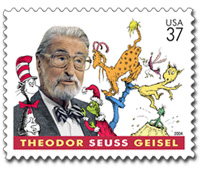 One of the favorite children’s authors of every generation, Dr. Seuss authored 66 books in all, and only four of these were in prose. Dr. Seuss was a wonderful illustrator and poet with a heart for rhythm (which he acquired from his mother) and a prodigious imagination which helped him create wonderful books for children. He invented animals (the Dawf, the Kweet, Wogs [Scrambled Eggs Super, 1953]), alphabets (On Beyond Zebra, 1955), and rhythms that keep his books fresh and alive even today. There are plenty more fascinating facts to be found at the Dr. Suess official website.
One of the favorite children’s authors of every generation, Dr. Seuss authored 66 books in all, and only four of these were in prose. Dr. Seuss was a wonderful illustrator and poet with a heart for rhythm (which he acquired from his mother) and a prodigious imagination which helped him create wonderful books for children. He invented animals (the Dawf, the Kweet, Wogs [Scrambled Eggs Super, 1953]), alphabets (On Beyond Zebra, 1955), and rhythms that keep his books fresh and alive even today. There are plenty more fascinating facts to be found at the Dr. Suess official website.
This week, the International Reading Association's Children’s Literature Special Interest Group (CL/R SIG) presents reviews of selected new books that are inspired by Dr. Seuss. The titles are imaginative, creative, and rhythmic. Their effervescent energies are certain to inspire the child in you to get dancing or dreaming!
Grades K-3
Byous, Shawn. (2014). Because I stubbed my toe. North Mankato, MN: Capstone Young Readers.
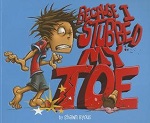 If your students need a smile, this is a great book to read. The story, narrated in first person, opens as a young boy stubs his toe. The impact of his toe shook the chair noisily and scared the dog. The dog scared the cat and the cat jumped out of the window. It landed on the head of girl, who dropped her ice cream cone that caused a biker to slide off the sidewalk and into a hive of bees. The bees attacked an old man who jumped into the pond. The splash surprised a woman, who tripped on a teeter-tooter. One unfortunate child got tossed high into the air and luckily landed on a crowded bouncy house. It sent the kids running and screaming straight into the zoo. It scared the elephants out of their cages and they were soon trampling down the street, and knocked over an ice cream truck. And guess whose window was open to grab the ice cream? A hilarious book, sure to get kids giggling!-
If your students need a smile, this is a great book to read. The story, narrated in first person, opens as a young boy stubs his toe. The impact of his toe shook the chair noisily and scared the dog. The dog scared the cat and the cat jumped out of the window. It landed on the head of girl, who dropped her ice cream cone that caused a biker to slide off the sidewalk and into a hive of bees. The bees attacked an old man who jumped into the pond. The splash surprised a woman, who tripped on a teeter-tooter. One unfortunate child got tossed high into the air and luckily landed on a crowded bouncy house. It sent the kids running and screaming straight into the zoo. It scared the elephants out of their cages and they were soon trampling down the street, and knocked over an ice cream truck. And guess whose window was open to grab the ice cream? A hilarious book, sure to get kids giggling!-
-Rani Iyer, Washington State University Pullman
Ering, T. B. (2014). The almost fearless Hamilton SquidLegger. Somerville, MA: Candlewick Press.
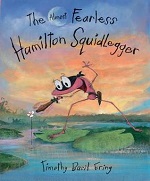 If you want to engage your students in making up words and gently introduce them to the art of exploring the world on their own, this book is a great aide. During daylight hours, Hamilton has no problem slaying all the frackensnappers, skelecragons, or bracklesneeds in the swamp where he lives. However, at sundown, Hamilton has to escape into his secret hideaway!
If you want to engage your students in making up words and gently introduce them to the art of exploring the world on their own, this book is a great aide. During daylight hours, Hamilton has no problem slaying all the frackensnappers, skelecragons, or bracklesneeds in the swamp where he lives. However, at sundown, Hamilton has to escape into his secret hideaway!
That is until his father tempts him with his absolute favorite treat—a double-decker grasshopper worm-cake, with a snake-belly frosting. Hamilton had to stay in his mud all through the night to win it. At night, there is another downpour in the swamp, but Hamilton, shivering and nervous, stays in this mud. In an elaborate dream sequence, brilliantly illustrated, Hamilton meets other creatures, who take him on a ride over the ocean, an airship from where Hamilton can see the whole world—mountains, forests, animals, meadows, oceans, and rainbows! Excited and tired, Hamilton is ready for bed. And all his friends brush up and huddle to hear Hamilton’s dad read to them. Soon, they all sleep in their own mud, fearless at last!
-Rani Iyer, Washington State University Pullman
Hoberman, Mary Ann. (2014). You read to me, I’ll read to you: Very short tall tales to read together. Illus. by Michael Emberley. New York, NY: Little, Brown & Company.
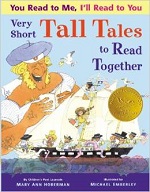 Celebrating Dr. Seuss would be incomplete without the inclusion of the work of past Children’s Poet Laureate Mary Ann Hoberman. The thirteen short stories in this volume retell stories of America’s heroes and heroines. Their deeds are amazing and larger than life.
Celebrating Dr. Seuss would be incomplete without the inclusion of the work of past Children’s Poet Laureate Mary Ann Hoberman. The thirteen short stories in this volume retell stories of America’s heroes and heroines. Their deeds are amazing and larger than life.
The book presents the tall tales of Annie Oakley, Davy Crockett, John Henry, Slue-Foot Sue, Mike Fink, Casey Jones, Don-Jose Love-mad Lopez, Johnny Appleseed, Paul Bunyan and many more in rhymes. The rhymes are meant for two voices, each portion indicated in different color. The rhymes present great opportunities for young students to practice early reading theatre activities, and even put up plays based on these rhymes. The characters presented are of various nationalities that settled the United States during the pioneer era, although there is a paucity of Native American and Asian characters in this volume. This is a wonderful volume for English language learners to practice their reading skills.
-Rani Iyer, Washington State University Pullman
Kennedy, Anne Vittur. (2014). The farmer’s away! Baa! Neigh! Somerville, MA: Candlewick Press.
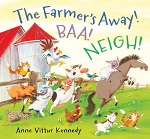 The happy hours for the barnyard animals begin when the farmer leaves. They go rafting and picnicking, ride on a roller-coaster and a hot air balloon, and dance on the meadow during the sunset while everyone is dressed up. The dog’s cry, the signal to indicate farmer’s return, seems just like the striking sound of a clock for Cinderella. It reminds the animals to return to reality and they rush and dash back to the barnyard where they are supposed to be. Everything is like what it used to be.
The happy hours for the barnyard animals begin when the farmer leaves. They go rafting and picnicking, ride on a roller-coaster and a hot air balloon, and dance on the meadow during the sunset while everyone is dressed up. The dog’s cry, the signal to indicate farmer’s return, seems just like the striking sound of a clock for Cinderella. It reminds the animals to return to reality and they rush and dash back to the barnyard where they are supposed to be. Everything is like what it used to be.
The story primarily relies on the illustrations of the happy anthropomorphized animals to tell the story, while all written text is composed of onomatopoeia. The endpapers show the animal-sound index with which readers can consult. By following the animal rhymes, readers will enjoy the rhythmic lines!
-Ying-Hsuan Lee, Washington State University Pullman
Levy, Janice. (2014). Thomas the Toadilly Terrible bully. Illus. by Bill Slavin and Esperança. Grand Rapids, MI: Eerdmans Books for Young Readers.
 Moving to a new town, Thomas the Toad is craving attention. He dresses up to impress and acts as a bully in a hope of getting everyone’s eyes on him. However, no one cares because he isn’t scary and mean enough. When Gomer arrives, Thomas thinks that he has found a target he can bully. After making Gomer cry, Thomas feels guilty for what he’s done. However Gomer has bigger problems. He confesses that he has a bigger, stronger, and fiercer bully chasing after him. Thomas decides to help Gomer fight back against the bully. This story reminds readers that there are better ways to make friends instead of being a bully. Show your big heart and lend a hand to someone in need.
Moving to a new town, Thomas the Toad is craving attention. He dresses up to impress and acts as a bully in a hope of getting everyone’s eyes on him. However, no one cares because he isn’t scary and mean enough. When Gomer arrives, Thomas thinks that he has found a target he can bully. After making Gomer cry, Thomas feels guilty for what he’s done. However Gomer has bigger problems. He confesses that he has a bigger, stronger, and fiercer bully chasing after him. Thomas decides to help Gomer fight back against the bully. This story reminds readers that there are better ways to make friends instead of being a bully. Show your big heart and lend a hand to someone in need.
-Ying-Hsuan Lee, Washington State University Pullman
Morris, Richard, T. (2014). This is a moose. Illus. by Tom Lichtenheld. New York, NY: Little, Brown Books for Young Readers.
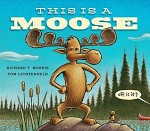 An animal crew is filming the life of Mighty Moose, who wants to be an astronaut in the wood by the riverside. As the leading actor, Mighty Moose is always ready to fly to the moon in his space suit, but Duck (the director) asks the animal actors to behave like animals. Ignoring director Duck’s request, the animal crew launch Mighty Moose safely in outer space, and then the whole filming team follows Mighty Moose to space to shoot the movie there.
An animal crew is filming the life of Mighty Moose, who wants to be an astronaut in the wood by the riverside. As the leading actor, Mighty Moose is always ready to fly to the moon in his space suit, but Duck (the director) asks the animal actors to behave like animals. Ignoring director Duck’s request, the animal crew launch Mighty Moose safely in outer space, and then the whole filming team follows Mighty Moose to space to shoot the movie there.
This is a humorous and hilarious story with anthropomorphized animal narrators and actors. The two-page, colorful illustrations created in ink, pencil, and gouache vividly capture the motion of animals with the use of movement lines, which is also featured in Dr. Seuss’s illustrations, to provide visual effect. The pleasure of reading this book is augmented by the endpapers and a glossary of filmmaking terms introduced in the book.
-Ying-Hsuan Lee, Washington State University Pullman
Parenteau, Shirley. (2014). Bears in the bath. Illus. by David Walker. Somerville, MA: Candlewick Press.
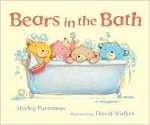 Although dusty, muddy, sweaty and stinky, the four little bears don’t want to take a bath! Getting dirty after a wrestle with four little bears, Big Brown Bear decides to jump in the tub first! Splish, Splash, Sploosh! How happy he is! Tempted by the big bear, four little bears finally hop into the tub and have a fun moment with bubbles and giggles.
Although dusty, muddy, sweaty and stinky, the four little bears don’t want to take a bath! Getting dirty after a wrestle with four little bears, Big Brown Bear decides to jump in the tub first! Splish, Splash, Sploosh! How happy he is! Tempted by the big bear, four little bears finally hop into the tub and have a fun moment with bubbles and giggles.
The furry bear illustrations with warm colors invite young readers to read about an experience that many of them may share in their daily routine. The text is meant to be read aloud. The reverberating sound of the words adds to the joy of reading this story!
-Ying-Hsuan Lee, Washington State University Pullman
Rissman, Rebecca. (2014). A dog’s day. Illus. by Becka Moor. Chicago, IL: Raintree.
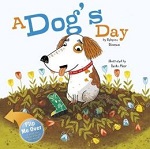 Introducing young readers to point of view is difficult. In this lovely, upside-down book, the readers read the story from the perspective of Rusty the dog and Rosie the girl, who walks and plays with him every day. Rusty, without his leash and owner, decides to walk into the stores and jumps into the fountain in the town square. He is surprised and sad when nobody welcomes him. Sometime later, Rusty realizes that he is hungry and lost when he hears a familiar voice calling his name. At this point in the story, Rosy and Rusty meet and the reader must flip over the book to read Rosie’s part of the story.
Introducing young readers to point of view is difficult. In this lovely, upside-down book, the readers read the story from the perspective of Rusty the dog and Rosie the girl, who walks and plays with him every day. Rusty, without his leash and owner, decides to walk into the stores and jumps into the fountain in the town square. He is surprised and sad when nobody welcomes him. Sometime later, Rusty realizes that he is hungry and lost when he hears a familiar voice calling his name. At this point in the story, Rosy and Rusty meet and the reader must flip over the book to read Rosie’s part of the story.
The book is a great way to introduce characters and POV. The storyline is really simple and even the youngest readers can actually ‘see’ where the characters meet and the two strands ‘twine.’ This is a great book for the youngest readers.
-Rani Iyer, Washington State University Pullman
Spires, Ashley. (2014). The most magnificent thing. Tonawanda, NY: Kids Can Press.
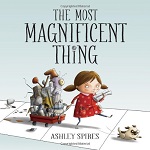 In this story, a little girl decides that she will make the most magnificent thing in the world. She gathers few things and puts them together with the help of her pet dog. She knows how it will look, and she also knows how it will work. Easy-peasy! However, things are not the same when she starts working on the project.
In this story, a little girl decides that she will make the most magnificent thing in the world. She gathers few things and puts them together with the help of her pet dog. She knows how it will look, and she also knows how it will work. Easy-peasy! However, things are not the same when she starts working on the project.
It is not as magnificent as she wanted, it is not good, and it does not even work! She tries hard to make it better—change the shape, give it legs, maybe the antennae would do the trick, or maybe make it fuzzy. They are all different, but not magnificent. Her assistant helps her cool off her anger with a walk. And she comes back to create the most magnificent thing ever! Young readers will love the surprise ending. Readers learn that not everything comes out “just the right way” instantly.
-Rani Iyer, Washington State University Pullman
These reviews and resources are submitted by members of the International Reading Association’s Children’s Literature and Special Interest Group (CL/R SIG) and are published weekly on Reading Today Online.
The CL/R SIG will host a special session entitled Children's Literature: The Perfect Teachable Moment on Saturday, May 10 at 3:00 p.m. at the International Reading Association 59th Annual Conference in New Orleans. The session celebrates award-winning children's and young adult books and authors. Author Nancy Bo Flood is the keynote session speaker. Her work encompasses more than a dozen books. Her recent historical fiction "Warriors in the Crossfire" is set in Saipan during WWII, and was selected on the 2011 Notable Books for a Global Society (NBGS) list. The NBGS list represents selections and authors from all genres K-12, with a focus on understanding of and appreciation for the world's full range of diverse cultures, ethnic, and racial groups. The session will also include presentation of the 2014 Notable Books for a Global Society (NBGS) list by members of the selection committee. Visit http://www.iraconference.org to learn more about IRA 2014 or to register.